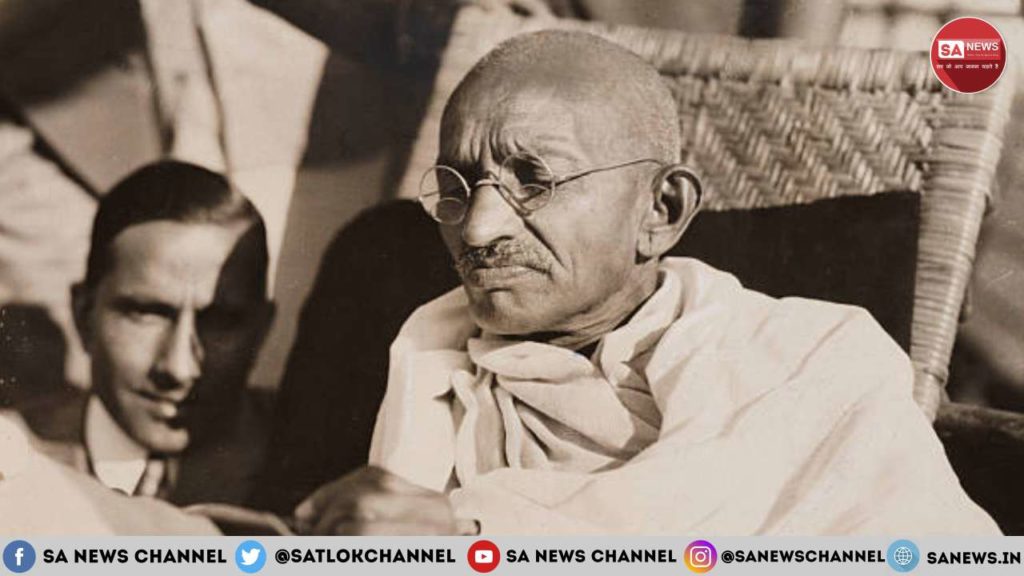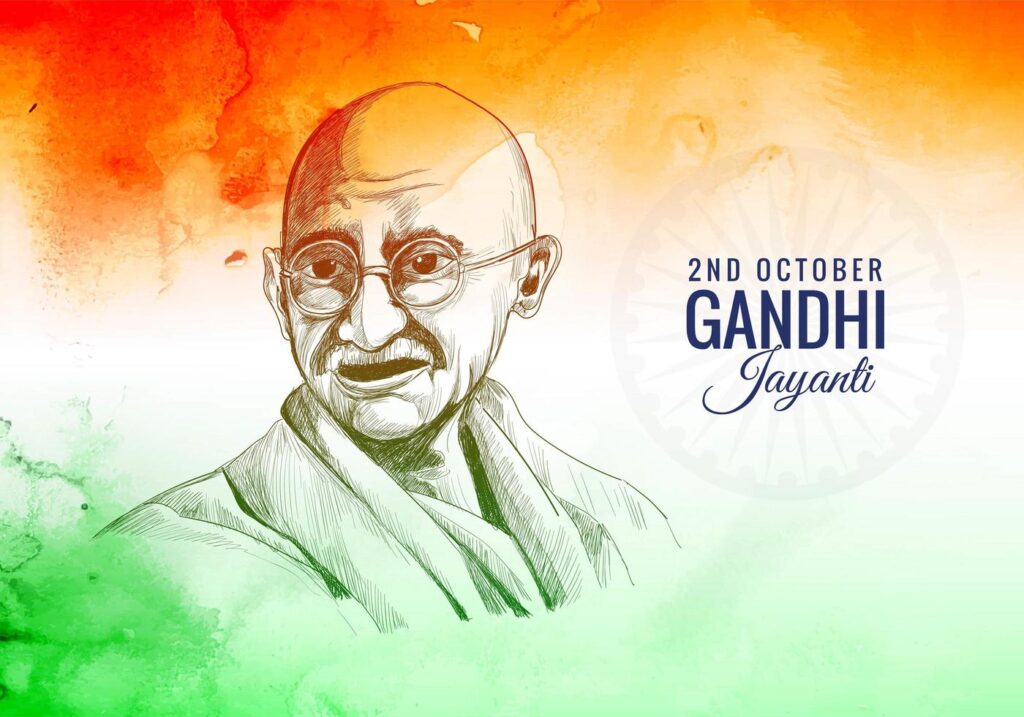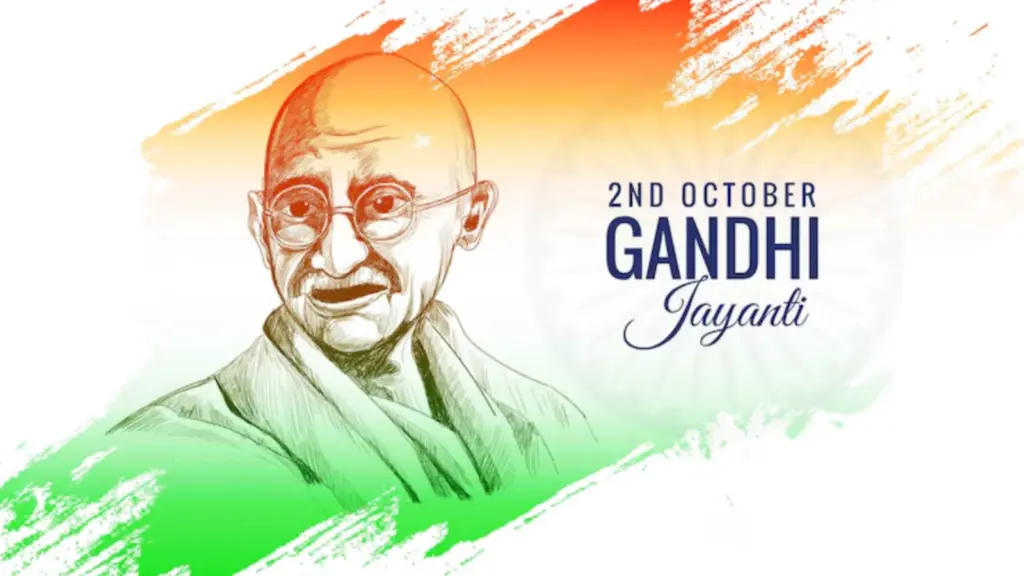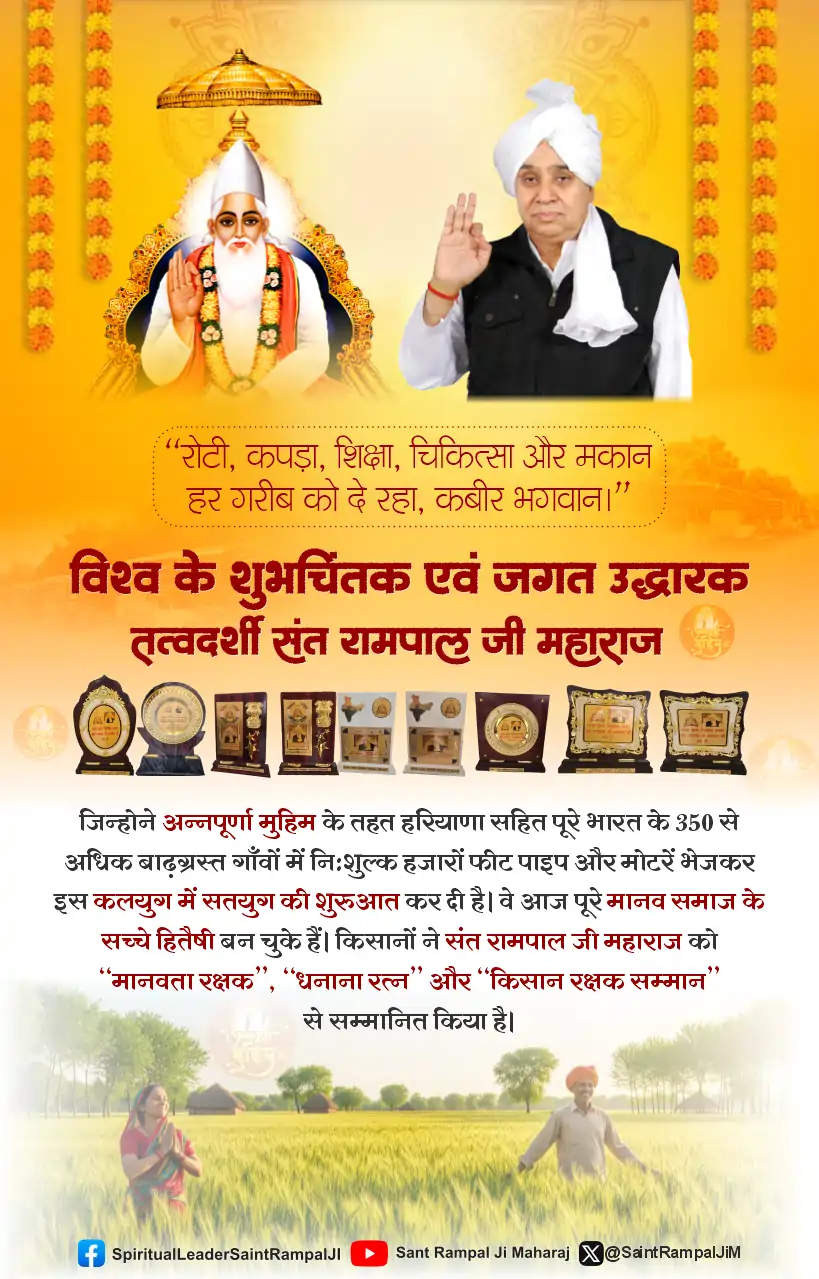Last Updated on 1 October 2025 IST | Gandhi Jayanti 2025: Today through this blog light will be thrown on Mahatma Gandhi’s Jayanti and why he is considered to be the Father of the nation. Along with this, the blog will brief the readers about who is actually the Father of each and every soul present in all the universes. To know everything, just explore the blog completely.
Introduction About Gandhi Jayanti
Gandhi Jayanti is basically the birth anniversary of Mohandas Karamchand Gandhi widely known as Mahatma Gandhi or Bapuji in remembrance of his vital endeavors in accomplishing India’s Independence. Mahatma Gandhi was born on 2nd October 1869 in Gujarat’s Porbandar and belonged to a merchant’s family.
He studied law from the University of London and went to South Africa to practise it at the age of 24. In 1915, at the age of 45, he came back to India and joined the Indian National Congress for attaining the nation’s freedom and soon became its president. There he commenced various peaceful protests and passive movements against the British administration which included the Non-Cooperation movement, Salt Satyagraha, Civil Disobedience movement, Quit India movement, etc.
Swachhotsav / Cleanliness Campaign
The Ministry of Cooperation has launched a special Swachhotsav campaign under PM Modi’s leadership to coincide with Gandhi Jayanti and Swachh Bharat Diwas. As part of this, the “Ek Din, Ek Ghanta, Ek Saath” campaign encourages groups to devote one hour collectively for cleanliness work. On 2 October, large-scale public participation in cleanliness drives is expected across states, cooperative organizations, and public bodies.
‘Ek Tareekh, Ek Ghanta, Ek Saath’ Campaign by Modi
Modi made a call to citizens to take part in the cleanliness drive on 1 October at 10 am for 1 hour. He also said that to make Swatch Bharat is the responsibility of every citizen. He also emphasized it in the 105th episode of Mann ki Baat in which he encouraged everyone to be a part of this program throughout the country. The ‘Ek Tareekh, Ek Ghanta, Ek Saath’ Campaign is the special part of this Gandhi Jayanti this year. This initiative is a part of the 2025‘Swachhata Pakhwada- Swachhata Hi Seva’ campaign.
Since When Do We Celebrate Gandhi Jayanti?
The date on which Gandhi Jayanti is celebrated happens to be October 2nd annually which is also a national holiday featuring his struggle for the nation’s freedom and is also the prime reason why Gandhi Jayanti is celebrated every year. And this year Gandhi Jayanti 2025 is going to be the 153nd birthday of Mahatma Gandhi.
Gandhi Jayanti 2025 Celebrations
On this day (Gandhi Jayanti 2025), irrespective of religion, people remember his struggle and his peaceful methodology for the nation’s independence. People prefer to do the following on this day:-

- Various political leaders pay homage by visiting Raj Ghat in New Delhi.
- Sale of alcohol is prohibited on this day. While we are unaware of the fact that consumption of alcohol is against the constitution of God Kabir, hence prohibition of alcohol shouldn’t be limited to a single day. It should be banned for the welfare of the society.
- Students take part in Gandhi Jayanti essay and Gandhi Jayanti speech narration, Quiz competition, etc.
- This day is also celebrated as International Day of Non Violence around the globe.
Gandhi Jayanti 2025: The Facts
- Date: 2 October 2025 (Thursday)
- Anniversary: 156th birth anniversary
- National Holiday: Gandhi Jayanti is one of three national holidays in India.
- International Day: Since 2007, the United Nations recognizes Gandhi’s birthday as the International Day of Non-Violence.
Do We Adhere to Gandhi Ji’s Principles?
Gandhi Jayanti 2025: The real essence of this day is in understanding the true meaning of it and adhering to it. Today, no one seems to follow non-violence. There is chaos and violence everywhere. There can never be peace in this world because this world belongs to Kaal-Brahm (Satan) and he will never let peace prevail in this world.
Read in Hindi: गांधी जयंती (Gandhi Jayanti) पर जानिए वर्तमान में कौन है सत्य व अहिंसा के सच्चे पथ प्रदर्शक?
A Brief Biography of Mahatma Gandhi
Mahatma Gandhi, born on October 2, 1869, in Porbandar. Mahatma Gandhi’s father, Karamchand Gandhi, served as the chief minister (diwan) of Porbandar, a coastal city in present-day Gujarat, India. He held a prominent administrative position under the ruling state of Porbandar. While his mother, Putlibai, was deeply religious.

Mahatma Gandhi’s initial education began at a local school in Porbandar, where he learned basic subjects and developed a love for reading. At the age of 13, he moved to Rajkot to continue his studies. In 1888, he traveled to London to study law at University College London, where he also experienced Western culture and ideas, which influenced his later philosophy and activism.
He married Kasturba Makhanji at age 13, and they had four children: Harilal, Manilal, Ramdas, and Devdas, who played significant roles in his life.
Mahatma Gandhi, was a prominent leader in the Indian independence movement against British rule. Educated in law at University College London, he initially practiced in South Africa, where he developed his philosophy of non-violence (Ahimsa) and truth (Satya). Returning to India in 1915, Gandhi became a key figure in the struggle for independence, advocating for civil disobedience and peaceful protests. His leadership in movements like the Salt March in 1930 galvanized millions and inspired global civil rights movements. Gandhi emphasized self-reliance, promoting the use of khadi (handspun cloth) to boycott British goods. Despite facing imprisonment and opposition, his unwavering commitment to non-violence earned him the title “Mahatma,” meaning “Great Soul.”
Although our nation became independent 75 years ago, the soul of each and every living being is still entrapped here in the cycle of birth and death because Satan (Kaal Brahm) doesn’t let us know the methodology to attain ultimate peace through his acts of keeping us away from it like engaging us in fights over issues that are totally irrelevant, say fight between people of 2 religions, 2 sects.
Though Mahatma Gandhi is being referred to as the father of the nation, recognizing the one actual FATHER of every soul here (who in actuality completes the meaning of GOD IS ONE) who can liberate us from the ferocious cycle of birth and death is the true factual significance of this day.
How Gandhi’s Experiences Inspired His Fight for India’s Freedom
Mahatma Gandhi’s experiences in London and South Africa profoundly influenced his commitment to India’s freedom struggle. In London, he encountered diverse political and social ideas, including concepts of democracy, justice, and individual rights. This exposure shaped his belief in non-violent resistance.
In South Africa, where he faced racial discrimination, Gandhi developed his philosophy of non-violence (Ahimsa) and truth (Satya) as effective means of protest. He organized the Indian community against oppressive laws, using peaceful civil disobedience to challenge injustice.

These experiences convinced him that India’s fight for independence required a similar approach. Upon returning to India, he applied these principles, mobilizing masses through non-violent protests, such as the Salt March and the Quit India Movement. Gandhi’s commitment to non-violence inspired millions and became a powerful tool in the struggle for India’s freedom from British colonial rule.
Key Figures Who Supported Gandhi ji in the Fight for Independence
Mahatma Gandhi was supported by numerous individuals and groups in the fight for India’s independence. Key figures included:
1. Jawaharlal Nehru: A close associate and future Prime Minister, Nehru played a significant role in mobilizing the youth and advocating for independence.
2. Sardar Vallabhbhai Patel: Known as the “Iron Man of India,” Patel was a key leader in the struggle and worked closely with Gandhi on various movements.
3. Subhas Chandra Bose: Although he had different strategies, Bose was a prominent leader who sought independence through more militant means.
4. C. Rajagopalachari: A loyal follower of Gandhi, he played an essential role in various movements and was instrumental in spreading Gandhi’s message.
5. Kasturba Gandhi: His wife, who supported him throughout his journey and was actively involved in the freedom movement.
6. Mahatma Gandhi’s Followers: Thousands of ordinary Indians, including farmers, women, and students, participated in non-violent protests, marches, and civil disobedience campaigns.
7. Indian National Congress: The party became the primary political platform for advocating independence, rallying millions under Gandhi’s leadership.
Together, these individuals and groups contributed significantly to the Indian independence movement, advocating for justice and equality.
Lala Lajpat Rai’s Contribution to India’s Independence and Collaboration with Mahatma Gandhi
Lala Lajpat Rai was a prominent figure in India’s struggle for independence and worked alongside other freedom fighters, including Mahatma Gandhi. Though Lajpat Rai was associated with the more radical faction of the Indian National Congress, advocating for immediate self-rule (Swaraj), he shared the broader goal of Indian independence with leaders like Gandhi.
He supported Gandhi’s non-cooperation movement, and his leadership and sacrifices inspired many during the freedom struggle. However, Lala Lajpat Rai also believed in more assertive action when necessary, while Gandhi promoted non-violence and passive resistance. Both leaders played crucial roles in uniting Indians against British rule, albeit through different methods and ideologies.
Movements Led by Mahatma Gandhi in the Fight for Independence
Mahatma Gandhi led several significant movements during India’s struggle for independence, each characterized by his philosophy of non-violence and civil disobedience. Here’s a list of some of the most notable movements:
1. Champaran Satyagraha (1917): Gandhi’s first active involvement in Indian politics, this movement aimed to address the grievances of farmers in Champaran, Bihar, who were forced to grow indigo under oppressive conditions.
2. Kheda Satyagraha (1918): This movement supported farmers in Kheda, Gujarat, who were unable to pay taxes due to crop failure. Gandhi led a non-violent protest that resulted in tax relief for the farmers.
3. Non-Cooperation Movement (1920-1922): In response to the Jallianwala Bagh massacre and other injustices, Gandhi called for a nationwide non-cooperation campaign against the British government, urging Indians to boycott British goods, schools, and institutions.
4. Salt March (Dandi March, 1930): As part of the Civil Disobedience Movement, Gandhi led a 240-mile march to the Arabian Sea to produce salt, protesting the British salt tax. This act of defiance garnered widespread support and attention.
5. Civil Disobedience Movement (1930-1934): Following the Salt March, Gandhi called for the refusal to obey unjust laws, encouraging mass protests against British authority.
6. Quit India Movement (1942): In the face of World War II and growing discontent, Gandhi launched the Quit India Movement, demanding an end to British rule in India. The movement saw widespread protests and was met with harsh repression by the British.
7. Harijan Movement: Gandhi worked tirelessly for the upliftment of the “Untouchables,” whom he called Harijans (children of God), advocating for their rights and social equality throughout his life.
8. Khadi Movement: Promoting self-reliance, Gandhi encouraged the use of khadi (handspun cloth) as a means to boycott British textiles and foster economic independence. These movements were instrumental in mobilizing the Indian population against colonial rule and played a crucial role in the eventual attainment of independence in 1947.
Gandhi’s Messages for Post-Independence India
After India gained independence on August 15, 1947, Mahatma Gandhi emphasized several key messages to guide the nation forward. He urged the importance of unity and communal harmony, particularly between Hindus and Muslims, to heal the divisions exacerbated by partition. Gandhi reaffirmed his commitment to non-violence (Ahimsa) as a fundamental principle, advocating for peaceful conflict resolution and urging citizens to reject hatred.
He promoted self-reliance (Swadeshi) by encouraging support for local industries and the use of khadi to foster economic independence. Furthermore, he called for moral and ethical governance, emphasizing integrity and compassion in leadership. Lastly, Gandhi advocated for social justice, focusing on the upliftment of marginalized communities and the eradication of untouchability. Through these messages, he aimed to steer India towards a future of peace, justice, and sustainable development.
Reasons Behind Gandhi’s Assassination
- Mahatma Gandhi was assassinated on January 30, 1948, in New Delhi, India. The incident occurred at Birla House (now known as Gandhi Smriti), where he was attending a prayer meeting.
- Nathuram Godse, a Hindu nationalist who opposed Gandhi’s philosophy and approach killed him. Godse believed that Gandhi was too accommodating towards Muslims and blamed him for the partition of India, which led to significant violence and suffering.
- Gandhi advocated for communal harmony and non-violence, promoting peace between Hindus and Muslims during a tumultuous time. His efforts to support the payment of 55 crores to Pakistan following the partition angered some factions within India who felt he was compromising Hindu interests.
- Godse, driven by these beliefs, viewed Gandhi as a threat to Hindu nationalism and shot him during a prayer meeting in New Delhi. His assassination shocked the nation and highlighted the deep divisions and tensions present in post-independence India.
Why is Mahatma Gandhi Called the Father of the Nation?
Mahatma Gandhi was first referred to as the “Father of the Nation” by Subhas Chandra Bose in a radio address from Singapore in 1944. Bose used this title to acknowledge Gandhi’s immense contribution to the Indian freedom struggle and his role in uniting the masses through his philosophy of non-violence (Ahimsa) and truth (Satyagraha).
Gandhi’s leadership in major movements such as the Non-Cooperation Movement, the Salt March, and the Quit India Movement played a pivotal role in India’s fight for independence. His methods of peaceful protest, advocacy for civil rights, and efforts to uplift the marginalized made him a figure of national importance. Hence, he earned this title for being the guiding force behind India’s journey to independence.
Mahatma Gandhi’s most famous quotes
- “Be the change that you wish to see in the world.”
- “The best way to find yourself is to lose yourself in the service of others.”
- “In a gentle way, you can shake the world.”
- “An eye for an eye will only make the whole world blind.”
- “The greatness of a nation and its moral progress can be judged by the way its animals are treated.”
Why Gandhi’s Message Still Matters (2025 Lens)
Non-violence as Strategy & Ethic
In a turbulent world—with conflicts, protests, online vitriol, misinformation — Gandhi’s notion of non-violence is not passive. It is a courageous stance: resisting injustice not by force, but by moral persuasion, civil disobedience, and self-discipline.
When protests or movements turn violent, they lose moral authority. In contrast, non-violent discipline forces the other side to confront the legitimacy of their actions.
Truth in the Age of Disinformation
Gandhi held that “Truth is God.” In 2025, with disinformation, deepfakes, and echo-chambers, truth is under siege. His insistence on honesty even under hardship is a challenge to journalists, public figures, and citizens alike: to validate facts, be transparent, and resist propaganda.
Simplicity, Sustainability & Consumerism
Gandhi lived minimally: modest homes, wearing khadi, limited wants. In consumerist societies, such a stance calls us to reconsider excessive consumption, wasteful lifestyles, and ecological strain. The philosophy of “enough rather than more” aligns with contemporary sustainable development goals.
Self-reliance & Rural Empowerment
Gandhi’s vision of Swaraj (self-rule) was not just political but socio-economic: he championed village industries, local self-governance, and rural upliftment. In 2025, when urban-rural disparity is a pressing concern, his model suggests empowering local economies, small-scale enterprises, and decentralized governance.
Communal Harmony & Inclusivity
India’s religious and social diversity is simultaneously its strength and vulnerability. Gandhi’s tireless efforts toward Hindu-Muslim unity, abolishing untouchability, and promoting equality challenge our times of polarization. His ideal was not uniformity, but respectful coexistence.
Who Is the FATHER of Every Soul?
Though we cannot deny that everyone is living here with their beloved ones whom they call family and they have a father or a caretaker concerned for them. But the ONE who is nourishing everyone is the Creator of the entire universe and is the true father of the soul. The one who can take away all our sorrows and can satisfy all our essential necessities without even asking for it, He is none other than ’God’.
Only by Grace of that God, one can be absolutely satisfied with his life and can be entirely liberated from any sort of life-threatening disease. It is by God’s Grace only that a soul stays sheltered safely inside the mother’s womb where no one is there to help him out. Likewise, the same is revealed through Garibdasji’s God-given Verses:-
Mushkil mein aasan kiya tha, Kaha gayi wo Baatan|
Sat Sukrit ko bhuli gaya hai, Uncha Kiya na Hatha||
Do We Really Need to Find the True FATHER of Our Soul?
Yes, it is crucial for every living being in the universe to recognize and connect with their True Father, the immortal Supreme God, just as a father is an essential part of a family, providing unwavering support and care through life’s ups and downs. Similarly, a soul’s ultimate purpose is to realize its True Father, who, as revealed in Kabir Sahib’s verses, ensures that all its needs are provided for in advance.
Kabir, Kalpe karan kaun hai, Kar Sewa Nishkaam|
Mann iicha fal deunga, Jab Pade Mere se Kaam||
And by the grace of that God only, the trap of karmas and the hassle of birth and death into 84 lakh species of animals can finally conclude, thus liberating a soul to an eternal place Satyalok and attaining the Supreme God. On reaching Satyalok, a soul is free from diseases and bad deeds, thus becoming immortal. The same is depicted in Kabir Saheb’s Verses:-
Chal hansa Satyalok Humare, Chodo yeh sansara ho|
Iss sansar ka kaal hai raja, Karam ka jaal pasara ho||
Who Is the Supreme Father of the Universe?
In the present scenario, we see people in their respective religions worshiping Brahma, Vishnu, Mahesh, Goddess Durga, and other deities along with some messengers of God, like Jesus, Mohammad, and Guru Nanak Dev Ji and perform various sorts of rituals. All these Gods, demigods, the messenger of God are themselves entrapped into the trap of karmas and the cycle of birth and death, hence they cannot give us anything except our destiny which is already ours. And mankind worships these due to grave ignorance or we can call it lack of TATVGYAN (True spiritual knowledge).
He is none other than Lord Kabir or Kabir Saheb who came into Varanasi, Uttar Pradesh 600 years ago and appears by Himself (doesn’t take birth from a mother’s womb) onto this planet earth from Satyalok in all the four ages to impart the True spiritual Knowledge so as to ease the way of salvation for His pious souls i.e., for us. Accordingly the same is depicted in His Verses:-
Satyug mein Sat Sukrit Keh Tera, Treta Naam Muninder Mera|
Dwapar mein Karunamay Kahaya, Kalyug Naam Kabir Dharaya||
Sant Garibdas Ji (from Village Chhudani, District Jhajjar, Haryana) has also described in His God-given verses about the glory of Lord Kabir:-
Anant koti brahmand mein, Bandichhod Kahaye|
So To Ek Kabir hai, Janani Janay na May||
Lord Kabir Is the FATHER of Every Soul
He is the Supreme Power who is imperishable and by His Grace only the aggravation of birth and death can finally end and one’s soul can happily move to its native place Satyalok and never come back. He is the FATHER of all the Souls ranging from the smallest animal to the human being, who is fostering everyone everywhere.
He is the one who has been germinating the seed of worship in His keen and passionate souls since ages and is Himself encouraging everyone to follow the right path of worship. And now when the prime time of attaining salvation has come He has facilitated us with the comfort to achieve salvation with ease through His Truly Enlightened Saint. The same is being told in God-given Garibdass Ji’s and Daduji’s verses respectively:-
SatKabir Naam Karta ka, Kalp kare dil dewa|
Sumiran kare Surti Se Lape, Pawe Hari Pad Bheva||
Kabir Karta Aap hai, Duja naa koye|
Dadu puran jagat ko, Bhakti Dridavat Soye||
Lord Kabir is the one and only Omnipotent, Omnipresent, and Omniscient Supreme Power who is referred to in all the Holy Scriptures. Some of these are mentioned below:-
- In Holy RigVeda, Mandal no 9: Sukt 1 Mantra 1-9, Sukt 20 Mantra 1, Sukt 82 Mantra 1-2, Sukt 86 Mantra 26-27, Sukt 94 Mantra 1, Sukt 96 Mantra 16-20 and in Holy YajurVeda in Chapter 29 Verse 25 and in various other verses, Lord Kabir is mentioned as Kavir Dev.
- In Holy Shrimad Bhagwad Geeta, chapter 8 Verse 3, 8-10, chapter 15 verses 4, 17 and chapter 18 verse 62,64,66, Lord Kabir is mentioned as Param Akshar Purush.
The Scripture-based worship (mentioned in chapter 17 verse 23 of Holy Geeta ji) for attaining Supreme God, (which is also the aim of a human being) is being given by a Tatvdarshi Sant (Truly Enlightened Saint who is the sole representative of God Kabir) as mentioned in Holy Shrimad Bhagwad Geeta’s chapter 4 verse 34 and is also mentioned in Holy YajurVeda chapter 40 mantra 10.
Who Is the Truly Enlightened SAGE (Tatvadarshi Saint)?
A Tatvdarshi Sant is the one who can explain the meaning of chapter 15 verse 1-4 from Holy Shrimad Bhagwad Geeta Ji in accordance with the creation of the universe. And currently Saint Rampal Ji Maharaj is the only one who is successful in explaining the same to us and is also the one who is giving us the true path of worship as mentioned in our Holy scriptures.
Amongst all the saints around, He is the right one as revealed through the Holy Scriptures. And it has been observed that through the path of worship enlightened by Him, He is giving benefits to His devotees that were earlier just written in the Holy books like extending the life span, curing any life threatening disease. Now His devotees are experiencing these miracles and it has been proven that God Kabir favors His righteous soul who does His worship and abides by Him. The path of Truth and honesty favored by Mahatma Gandhi ji is being successfully implemented by Saint Rampal Ji Maharaj through His True Spiritual Sermons and worship. Lord Kabir Ji says:-
Satsang ki aadhi ghadi, Tapp k varsh hazar|
To bhi barabar hai nahi, Kahe Kabir Vichar||
In a world full of uncertainties, on seeing above said proofs, a pious soul should not waste his time in identifying the True FATHER of his soul and take refuge under Sant Rampal Ji Maharaj to allow Him to be the sole Protector of your soul in all your hardships.
To get detailed information about the way to attain Almighty and salvation, please listen to the spiritual Sermons on Sadhna TV channel from 7:30 pm IST onwards. To take initiation from Saint Rampal Ji Maharaj, please click here to fill the initiation form. One Can download the Book Gyan Ganga for more information.
Frequently Asked Questions (FAQ) About Gandhi Jayanti
Ans. Gandhi Jayanti is the birth anniversary of Mohandas Karamchand Gandhi widely known as Mahatma. It is celebrated in Gandhi’s remembrance for his vital endeavors in accomplishing India’s Independence.
Ans: Gandhi Ji is well known for his principle of non-violence, truth, Sarvodaya and Satyagraha, those constitute Gandhian philosophy and are the four pillars of Gandhian thought.
Non-violence, or Ahimsa, is a core principle in Gandhi’s philosophy, advocating for peaceful resistance against oppression. Gandhi believed that non-violent actions could bring about social and political change without causing harm, making it a powerful tool for justice and reconciliation.
Gandhi’s principles of non-violence and civil disobedience have inspired numerous global movements for civil rights and social justice, including the American Civil Rights Movement led by Martin Luther King Jr. and the anti-apartheid struggle in South Africa, demonstrating the universal applicability of his teachings.




